The leaves of the orchid have dropped. Excessive humidity level. Excessive use of fertilizers
One of the most difficult ornamental crops to grow at home. Caring for a plant must be approached with a full understanding of its biological characteristics and needs at different times of the annual cycle. Any violation in the care or in the conditions of detention, damage by diseases or pests immediately affects the condition of the leaves. They become lethargic, gradually turn yellow and die off.
The correct solution to the problem is possible only after the full establishment of the cause that led to the wilting of the orchid leaves. It is not uncommon for it to be hidden in completely obvious details, and it may also be the result of a serious illness.
Regardless of the cause, the plant needs quick and correct help. Postponing the procedure can lead to irreversible damage to the orchid's body, which often end in death.
Overheating of the substrate
Overheating of the substrate is detrimental to all plants, especially those with large leaf blades, like an orchid. Exposure to sunlight, constantly operating heating devices can heat the substrate to a critical temperature for the plant. This leads to overheating of the root system.
During the overheating of the roots in the body of the orchid, the process of transpiration is significantly enhanced - the evaporation of water through the stomata of the tissues of leaves, stems and pseudobulbs. It is the plant's defensive reaction that is triggered to cool down. Therefore, even with regular watering and the right amount of water, the orchid begins to lack nutrients.
If overheating of the substrate is detected, the plant must be rearranged to a cool and shaded place.
An orchid in this state should not be disturbed for 3-4 hours. After that, you need to restore the water balance in the substrate and in the tissues of the plant. To do this, a pot with an orchid is immersed in water at a temperature of 30 ° C-40 ° C for one hour.
After this procedure, the orchid leaves are sprayed with warm water from a spray bottle and dried with a soft cotton cloth. The plant treated in this way is placed in a bright place, shaded from direct sunlight at an air temperature of + 18 ° C-25 ° C. After 2-3 days, you can observe the complete recovery of the leaf plates.
Root damage
The structure of the roots and their role in the life of an orchid differs significantly from other plants. In addition to substrate attachment and delivery nutrients from it to plant cells, they participate in the process of photosynthesis, absorb moisture and nutrients from the air. Therefore, any damage to the roots immediately affects the appearance.
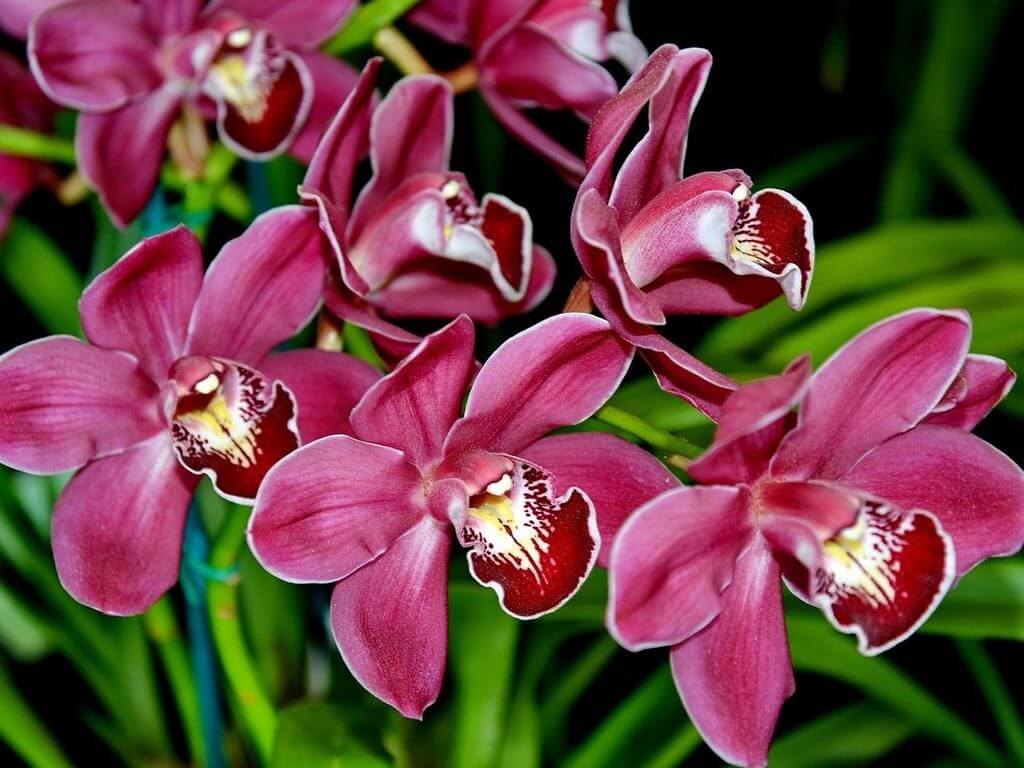
You can estimate the degree of root damage by slightly stirring the plant. If the orchid sticks tightly to the substrate, the problem is most likely mild dehydration. When the orchid dangles strongly from side to side, the plant must be removed from the container and the roots must be examined.
Healthy roots are dense and firm to the touch, light brown with an overgrown mass of young gray-white roots, which turn green when wet. Rotten roots are always empty, slimy and, when pressed, quickly expose the central part, which looks like a thin thread.
Root processing:
- cleaning and rinsing the roots under warm water;
- drying for 30 minutes;
- trimming rotten areas to healthy tissue with a sharp knife;
- processing of cuts with crushed activated carbon.
After that, the plant is planted in a new disinfected pot, the diameter of which is 2-3 cm less than the crown. With a root length of more than 4-5 cm, the orchid will easily recover within a week. If there are practically no roots left, the plant can be reanimated in another way.
For this, it is necessary to have formed root buds on the plant stem. They appear as dense, rounded tubercles on the underside of the stem. To grow roots, the orchid is placed in an empty container without holes in the bottom, and placed in a well-lit place at a temperature not lower than + 20 ° C.
In the first half of each day, water is poured into the container and left for 1-2 hours. In this case, the plant should be immersed in water only to the point of transition of the stem to underground. Every 20 days, the plant is fed with growth regulators, immersed in an aqueous solution of "Epin" (1 drop / 1 liter).
Once every 2 weeks, apply a weak solution of fertilizers with an optimal concentration of minerals for stimulating root formation (NPK 6-3-10). There is no exact time for the duration of resuscitation. With a combination of favorable factors, the orchid can recover in 1 month, and maybe in a year.
Violation of the humidity and watering regime
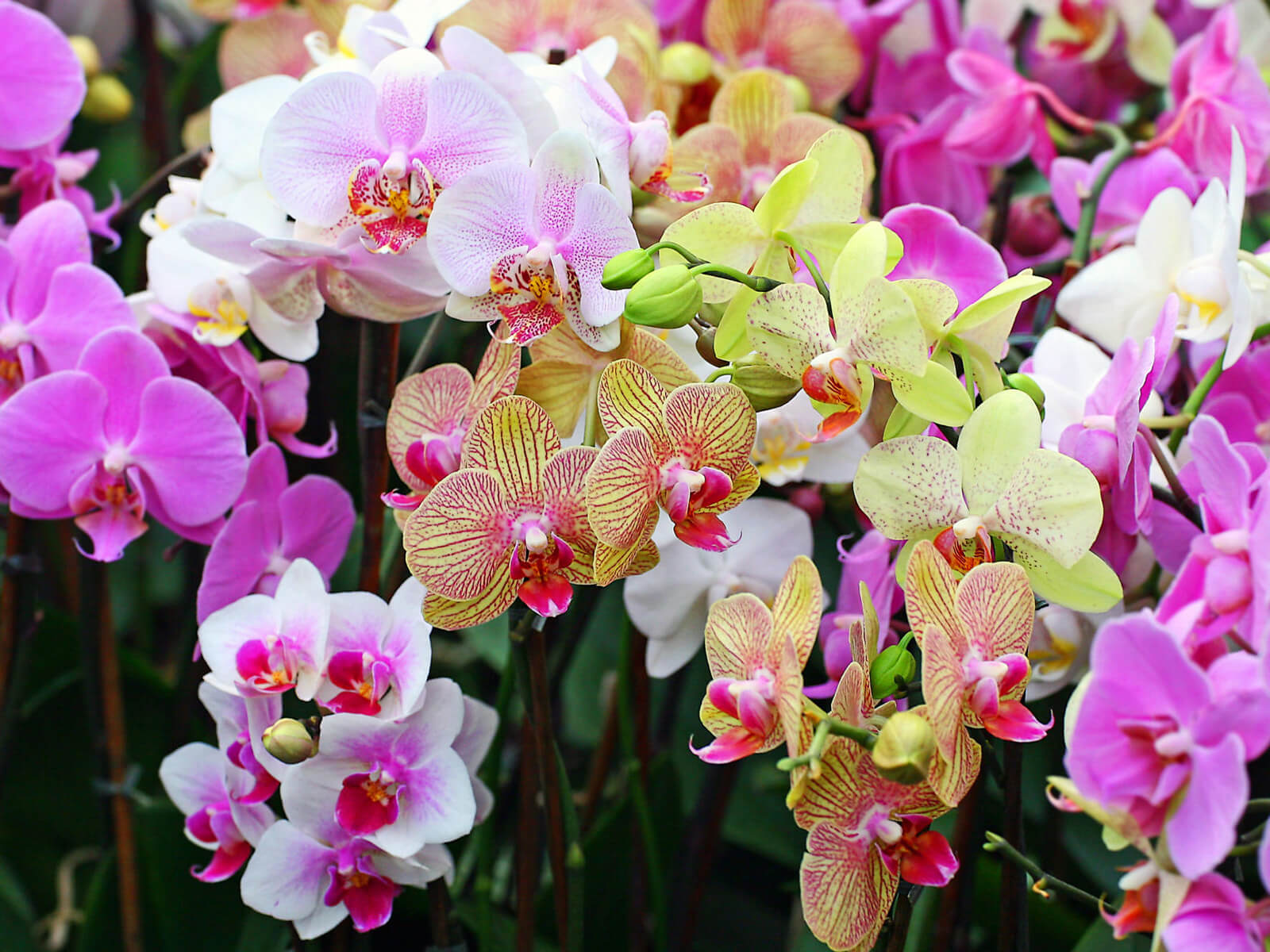
In their natural environment, orchids grow in the tropics, where heavy and short rains are poured every day. Then the substrate and roots dry out quickly under the influence of intensive air circulation. Thus, the roots and the plant itself are in a humid environment only for a short time.
Watering at home should be as similar as possible to the natural irrigation of the plant.
Water should flow abundantly, moisten the substrate and quickly go beyond the container. To do this, there must be holes and a drainage layer at the bottom of the pot, and the substrate should be loose. Water must not collect on the sump.
There is no exact scheme for watering an orchid. This is distinguished by the individual microclimate in each room. Therefore, all plant owners must learn to focus on the state of the substrate.
Orchids need to be watered when drops of condensation completely disappear from the walls of the pot, pieces of bark in the substrate dry out and the superficial roots acquire a silvery tint.
The optimum moisture content for good orchid development is 70% -80%. At home, it is quite difficult to maintain such parameters. Therefore, many growers make the mistake of spraying the orchid with water too often and incorrectly. The procedure is especially dangerous in winter and when the air temperature drops on summer nights.
The orchid is sprayed only in the morning, so that by night the leaves and stems of the plant are completely dry. In winter, the procedure is carried out in sunny weather and at an air temperature of at least + 18 ° C.
Excessive fertilization
An overabundance or lack of nutrients can affect the condition of orchid leaves. To avoid this, you need to choose the optimal mineral complex, fertilize correctly and in a timely manner.
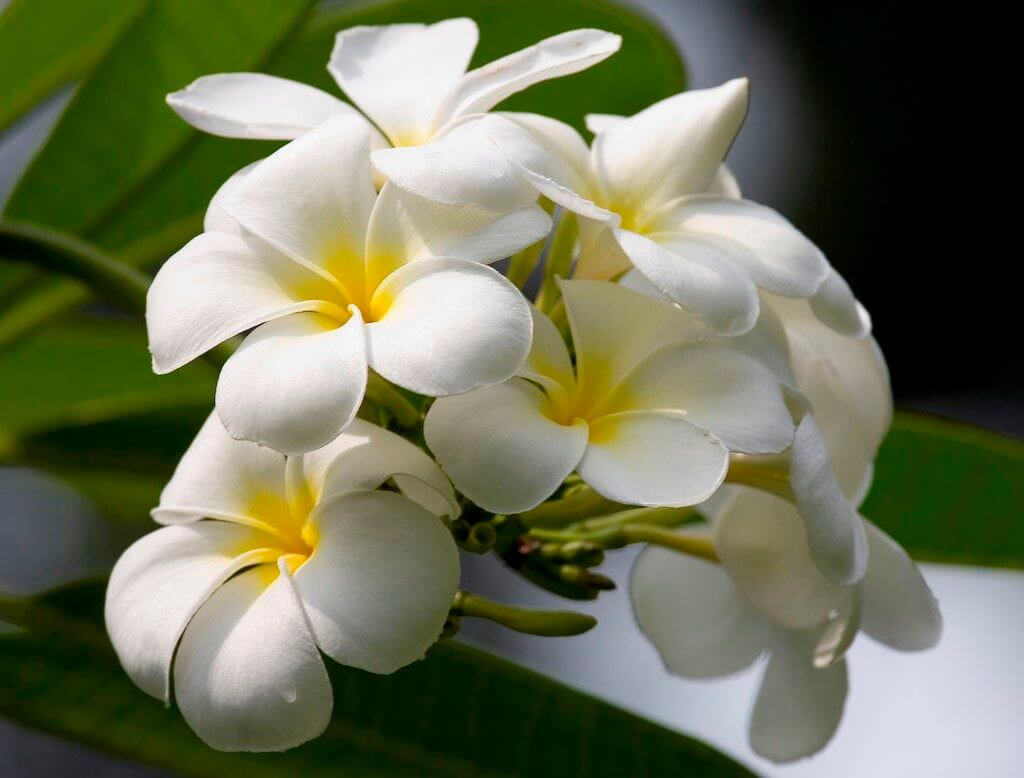
Orchids are epiphytes that do not tolerate the salinity of the substrate. Therefore, for plant fertilization, mineral complexes with a reduced content of macronutrients (NPK) with a normal concentration of microelements are chosen. Therefore, if non-special complexes for orchids are used in plant feeding, the concentration of the solution is made 3-4 times weaker.
Salinity can be identified by the appearance of a white coating on the surface of the substrate. This problem is possible with prolonged watering of the plant with hard water.
Elimination of salinity and overabundance of minerals from the substrate:
- preparation of a new substrate;
- rinsing orchid roots under running water;
- transplant.
During flowering, the plant cannot be transplanted. During this period, the abundant spill of the substrate with a solution of distilled and tap water 1: 1 will help to alleviate the condition of the plant.
Compaction of the substrate
Over time, you can observe the compaction of the substrate in the plant. This happens especially quickly when the irrigation regime is violated or when the selection of components for the substrate is incorrect.
This leads to a loss of air permeability - an important criterion for the correct development of the orchid.
The lack of oxygen at the roots disrupts the nutrition of everything, and first of all, the leaves begin to wither.
In this case, you need to transplant the orchid. The soil mixtures offered in garden centers do not always correspond to the expected quality, therefore many growers prefer to prepare the substrate with their own hands.
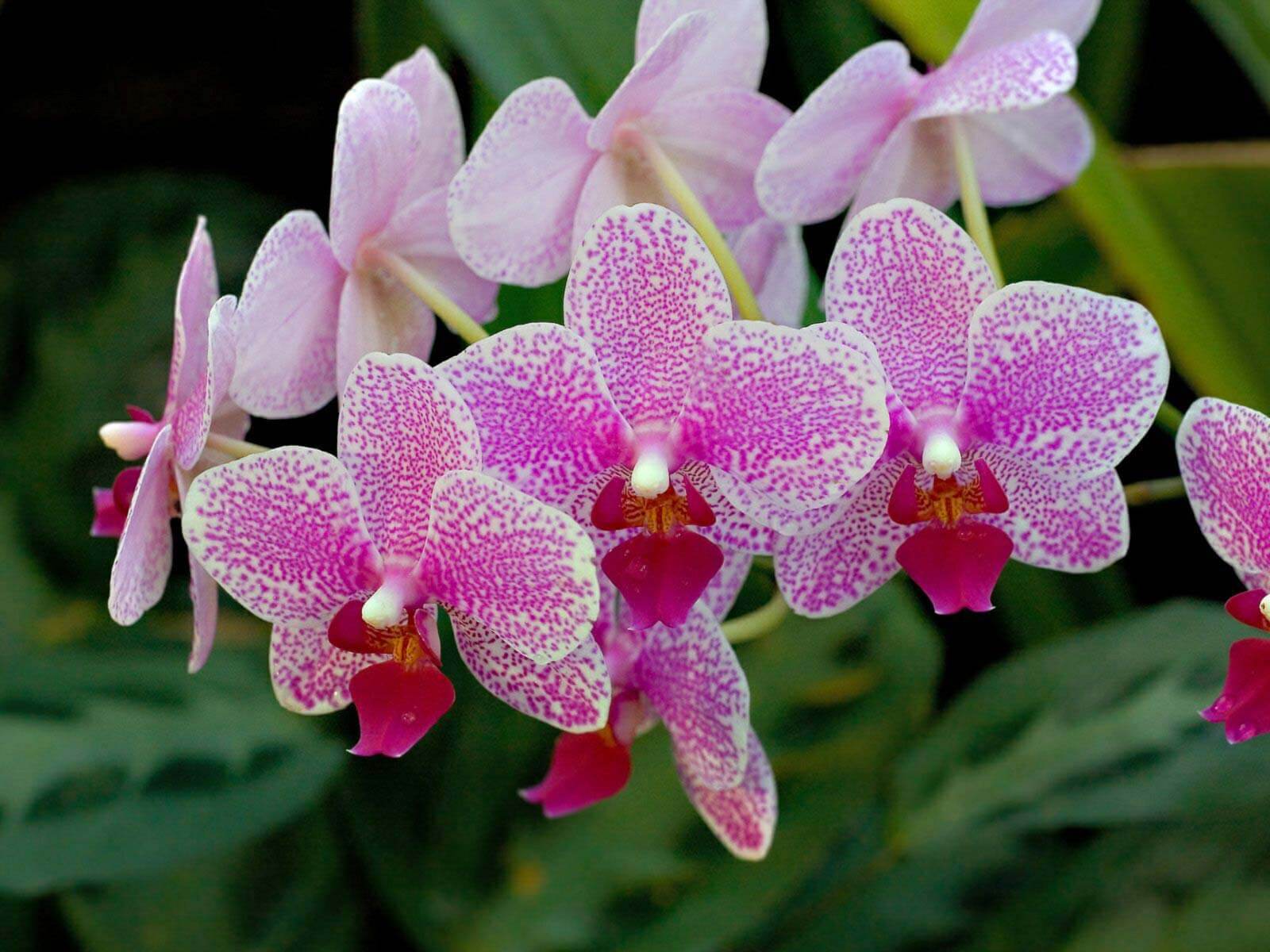
To do this, mix the components:
- bark (pine,) 70%;
- moss 10%;
- peat 10%;
- expanded clay 10%.
A prerequisite for keeping orchids is the presence of a drainage layer at the bottom of the pot. It should make up 15% of the total volume of the substrate.
Orchid pests
Increased humidity, compaction of the substrate and overfeeding of the orchid with fertilizers often create a favorable environment for the plant to be damaged by pests.
They feed on the juices of the aerial part and roots of the plant, damaging its tissues, which disrupts the rational intake of useful elements. Signs of pest activity can be seen by wilting leaves.
The main pests of orchids:
- scabbards;
- mealybugs;
- thrips;
- springtails.
The affected plant should be isolated and the substrate should be thoroughly dried. The leaf plates and the stem are washed with an aqueous solution of laundry soap (10g / 1l). The plant and the substrate are sprayed with Fitoverm or Actellik preparations.
To destroy nematodes, you need to spill the substrate with an aqueous solution of Levamisil (1 tablet / 1 l). These pests are sensitive to high temperatures, so spilling the substrate with water at a temperature of 40 ° C can help in the fight against them.
The basis of all possible orchid problems is the wrong position of the plant. The plant is ideally suited for warm eastern and western windowsills in a room where there are no cold drafts, but soft air circulation constantly occurs.
It is important for flower growers to take a closer look at outward appearance orchids. A common mistake is neglecting the problem in the early stages of development, when the internal structures are minimally damaged and the possibilities for preserving the orchid are much higher.
Have you noticed a mistake? Highlight it and press Ctrl + Enter to let us know.
Why does your orchid have sluggish leaves? We are looking for answers It happens that a healthy, prosperous plant suddenly loses the elasticity of its leaves. Why does the orchid have sluggish leaves, what should I do to restore turgor? There are several reasons and it will take time to restore beauty. It is clear that since the castings have lost their elasticity, the biochemical processes in the system are disrupted. Lack of moisture, overheating of the plant, or root diseases are the main reasons why an orchid withers. If you do not take action, the leaves will turn yellow, the plant will die. Causes of soft leaves in orchids
Usually the lower leaves become soft. If the ground part lacks nutrition, and the roots do not have time to fill the need, redistribution occurs due to the lower leaves. Their supply of food is transferred to the top. Overheating Overheating of the plant is dangerous for the flower. On a hot afternoon in direct sunlight, even a shaded window gets very hot. At this time, the leaf intensively evaporates moisture. But the substrate also heats up, evaporation is created in the glass. In this case, the roots not only receive little moisture, but also cool, the heat of the substrate is spent on evaporation. If overheating occurs, it is necessary: to remove the plant deep into the room for 2-3 hours, so that the temperature of the leaves and roots gradually level; after that you can spray the plant, wipe the leaves with a damp cloth or water; find a place for the orchid that excludes secondary overheating. An anti-stress drug, a drop of Epin or succinic acid can be added to the irrigation water. Turgor can recover quickly or within 3-4 days, depending on the degree of dehydration. Frostbite and pests
Why does an orchid have sluggish leaves in winter and what to do about it? Staying in a draft at sub-zero temperatures will freeze the leaves. They will lie down, turning into a rag. If the plant stands by the window in a harsh winter, frostbite will occur at temperatures below 15 degrees. Frostbite is not cured. The tissues are cut so that they do not develop rot. But there is no need to transplant a wounded flower. On the leaves, a colony of ticks has spread, they suck out the juice, the plant is inhibited and the green leaf still disappears. Red and colorless mites are especially dangerous for orchids. These insects are afraid of moisture, they breed only in dry air. After any water procedures, you need to dry the leaf sinuses and the center of the outlet. Stagnant water is harmful to the plant. Always use soft, settled water without hardness salts for plant care. Salts settle on the substrate, poison it and close the pores that contain moisture. Lack of moisture
What to do if the orchid leaves shriveled due to lack of watering? There is no clear time interval when the orchid substrate needs moisture. It depends on the dryness of the air and the temperature in the apartment. In the midday sun and in rainy weather, the selection of moisture by the roots changes. You need to water the dried out substrate. Therefore, make sure the soil is dry every time before watering. After drying, simply water the plant with the addition of succinic acid to the water. Watering is done by immersion for an hour in water 30-400 C.
For a long time, your favorite delighted you with her beauty. And, suddenly, you notice wilting. Possibly a subsequent fall. Leaves and flowers have such a nuisance. What happened? It is necessary to understand in detail.
It's hard to watch when the plant that you have been grooming is withering away. Moreover, there are species that differ precisely in their gorgeous foliage. But then they wither, turn yellow, and then fall off. Obviously, your beauty is either sick, or you screwed up with leaving. Debriefing always begins by identifying factors.
Reasons for wilting orchid leaves:
- Overheating of the roots.
Phalaenopsis are thermophilic. But everything has its own measure. Invalid things: your flower is constantly "under the gun" of the sun's rays. Hot air from an air conditioner is directed at it. The heating battery under the window sill on which the pot stands is too hot. Plus low humidity (50% or less).
What's happening?
The trunk, leaves, flowers get very hot. An active process of moisture evaporation begins. The soil also suffers. It overheats by evaporating water. The result is the cooling of the root system. "Cold" roots no longer consume the required amount of moisture. This means the leaves are not getting any nutrients. Result: flabbiness, yellowness, wilting. Everything happens quickly, in a few hours.
- Serious root damage
The following troubles occur with the root system: decay; drying out. Why? The first priority is the wrong care. The main factors influencing these processes:
- High humidity
Orchid is an epiphytic plant. That is, having "bare" roots. They fasten it to rocks, trees, caves. Frequent, warm tropical rains water the root system abundantly. And since it is not reinforced with soil, the water completely drains away. The warm air dries out the roots. So, until the next rain.
Home conditions do not allow much to keep such a flower with bare roots. This requires more care. Therefore, most varieties grow in soil. Let's say the pot is not chosen correctly (the wrong size), without enough holes. Then, with abundant watering, the substrate will always be wet. Disease may occur. When the roots acquire a brown tint, lose their elasticity, become lethargic, it means that problems have begun.
How to fix it?
It's simple. Bring the conditions of keeping the pet as close to natural as possible. Abundant watering with warm water - draining - drying. Drying is ensured by good air circulation in the room. Do frequent airing, avoiding drafts.
- Low humidity
The other extreme of the previous point. If an "experienced" florist tells you to water Phalaenopsis strictly every day, ignore such advice. First, each plant requires an individual approach. Affects species, origin. Second: meteorological parameters change daily. Such as: air temperature, humidity, sunshine, cloudiness. This is the starting point. In dry weather, high temperatures, water more often. When it gets cold or frosty, reduce watering. Be guided by the state of the substrate. It should be loose, moist (but not wet!).
- Incorrect feeding
Many people think: the more fertilizer, the better. This is not true. There are dressings where the concentration of minerals is different. The roots are extremely sensitive to this or that substance. Suddenly, there will be an overload of salts, the plant may die. It also takes into account the variety, periods of growth, dormancy, flowering.
- Soil compaction
Sometimes the orchid is transplanted into a new pot that has new soil. First, the root system grows, the old pot becomes small. The roots also suffer. Secondly, due to abundant watering, salts, the appearance of mold, fungi, the substrate is destroyed. It becomes denser. Air circulation is impaired. The roots feel a lack of oxygen. Consequence - they "suffocate" and die.
Roots are the circulatory system of the plant. Therefore, the combination of these factors causes problems, as well as in leaves.
Methods for treating wilting leaves
- Overheating: your actions. Create a shadow for the plant (just carry it into the interior of the room). Do not immediately fill it with water or spray it! Such actions cause the death of parts. Let it cool completely. The rest will take 2-4 hours. Then water in the usual way.
The water balance is restored up to four days. The regeneration of the affected parts is unlikely to happen overnight. So be patient.
If such a nuisance has occurred, find a comfortable zone for the flower. It is impossible to completely deprive the sunlight. Give him a table near the window. Or another part of the house. Perhaps the side of the world is simply not suitable for him.
- Root Damage: Your Action
When foliage withers, overheating plays a role only in 10% of cases. The rest is a violation of the function of the roots. Three degrees of injury are conventionally considered: light, medium, severe, very severe. Unlike the first three, the last degree means the death of the root system, and therefore the plant.
How to save?
- Take the phalaenopsis by the trunk, gently wiggle it back and forth. Does it sit firmly in the ground? The probable cause is drought. It's OK.
- Move the pot away from the heat source. Let him rest for one hour.
- After, place the flower in a container of water. Temperature +30 - +40 degrees. Let it stand for about an hour.
- Eliminate fertilizers or stimulants immediately. Otherwise, the situation will only get worse.
- Next, give your pet a warm, plentiful shower from top to bottom. Try to bypass peduncles.
- Let the water drain completely. Dry the leaves with a natural cloth. Better cotton.
- Find a well-lit area for your orchid, avoiding direct sunlight. The air temperature is moderate, +18 - 25 degrees.
- Wait 2-3 days, foliage will recover.
If there is no regeneration, it means that you started “resuscitation” late. In this case, atrophy of leaf tissues occurs. Or the death of some of the roots.
When the substrate with roots moves freely, remove it. Examine the root system carefully. What can you see there?
Living roots. Most often they are green in different shades. The main thing is elastic, solid, dense. Young roots are whitish when dry. Wet ones turn green. The old ones are darker.
Rotten roots. They are easy to identify. They are brown, soft, slippery. They resemble a hollow tube, when squeezed, moisture flows out.
What to do?
Inspect carefully. Remove the rotten, dried part with a sterile knife. Everything should be removed until healthy tissue. Sprinkle the slices with crushed activated charcoal. Alcohol-based disinfectants will only do harm. As they dry, they can "kill" the green part of the root.
Even if there is only one living root left, the plant may well recover. Plant the root (at least 5-6 cm long) in a small bowl with fresh, damp substrate. When it's dry, renew your regular watering.
What if the flowers wither?
What a pity when the luxurious buds suddenly fall off. There are reasons for everything. The plant is also a living being.
The factors causing these processes are almost the same as during wilting, leaf fall. We will just add something.
Changing your place of residence is not always enjoyable. Orchids are especially hard to tolerate. You bought a gorgeous flowering plant... They brought him home. Then the trouble began. Just moving, plus a new place, influenced your beauty so much. A different climate, different conditions of detention - enough for the flowers to begin to fall.
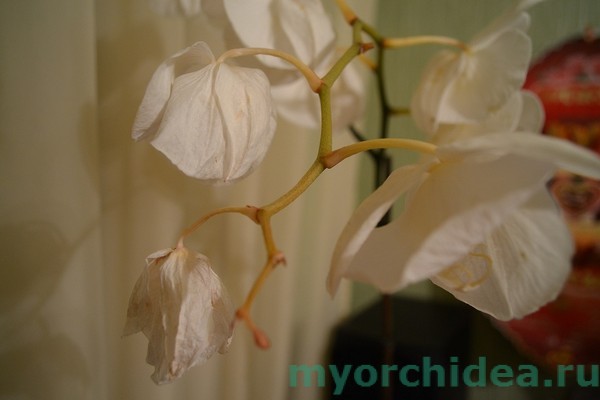
- Natural aging
Withering, dropping, dying off is a natural process. There is no eternal bloom. Some delight us with beautiful buds for a week or two. Others last for several months. In addition, it is not known how much phalaenopsis bloomed before you acquired it. Perhaps, when buying, this period was just ending.
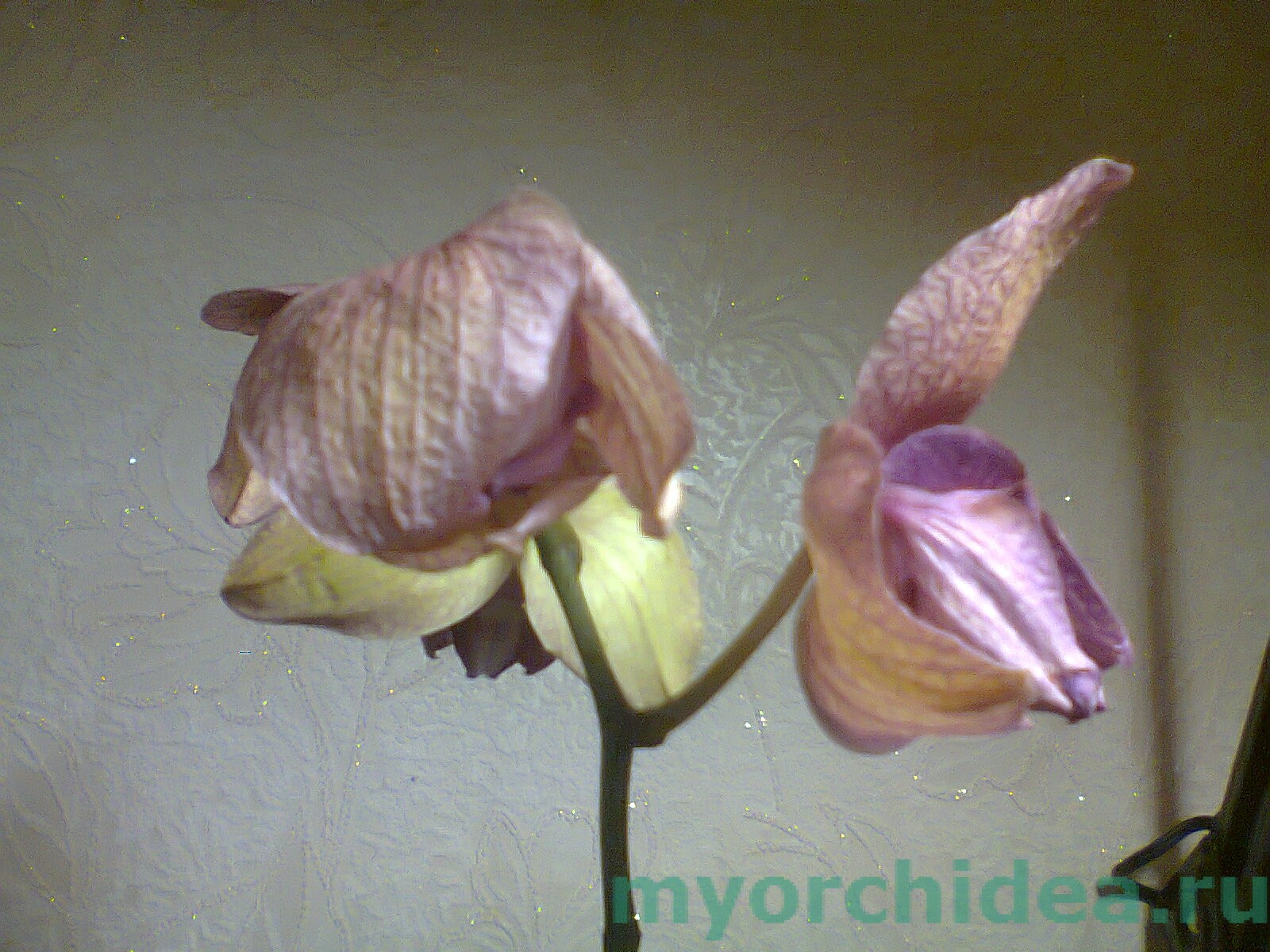
- Hypothermia
Orchids are thermophilic. Transporting it in winter is one of the reasons for the problem. Even when packaged well. At home, the temperature is also less than permissible. It is set at 22 - 32 degrees. Depends on the periods. Stick to modes. Especially the humidity of the air. The average rate is 70%. Its deficiency also serves as a factor in the dropping of flowers.
- Draft
Orchids need good air circulation. But the draft is destructive. It is enough to thoroughly ventilate the room.
- Food location nearby
Especially vegetables and fruits. Some of them release ethylene. This gas stimulates the ripening of flowers, even unopened buds. Rapid ripening leads to early wilting. Therefore, remove all food from the flower.
- Pollination
In warm periods, the pot is taken out to the open balcony, "to breathe". Small insects pollinate the plant. When everything goes well, the withering flower will replace the seed pod. If not, then it will disappear.
- Pests
Particularly conducive to damage. He loves the juice of the buds. Outwardly it looks like cotton wool. Leaves behind a sticky mark.
Today we will turn to the floral theme and talk about the orchid. The flower is undeniably beautiful and many people love it just for its beautiful flowers. But, as with many with an orchid, sometimes troubles also happen. We have already written about one such nuisance, when the plant does not want to bloom in any way (read). Today we will talk about carrying out resuscitation measures for an orchid. Such events will need to be carried out if your orchid turns yellow, and its leaves are slowly fading.
Why does the orchid fade and what to do in this case?
When the leaves wither, this is already a clear sign that your plant urgently needs help. If an orchid already lacks about 70 percent of its roots, then this help should generally be called resuscitation.
The reasons for this outcome may be different, but whatever they may be this moment, the orchid already needs to be saved. It is imperative to get it out of the pot and after that its root system is thoroughly and very carefully rinsed. Moreover, it is necessary to rinse it only in warm water and after rinsing all the rotten parts of the root system, as well as those roots that have already pererereli must be cut off.
But, it is possible that by the very root system of the orchid, you will not understand in any way which of its roots are still quite normal in their condition, and which of them are already completely rotten. Then, after washing, dry the plant well. In the summer, this is done without any problems - you spread the orchid, as they say, in the fresh air. It will be enough for her to lie there for twenty minutes or half an hour. After that, the roots will dry out quite well. If you carry out such a procedure in the winter, then here you need to dry the orchids more - about 2 or 3 hours. Do not be afraid to keep the orchid "naked", that is, without any substrate at all. She tolerates this well, and nothing will happen to her.
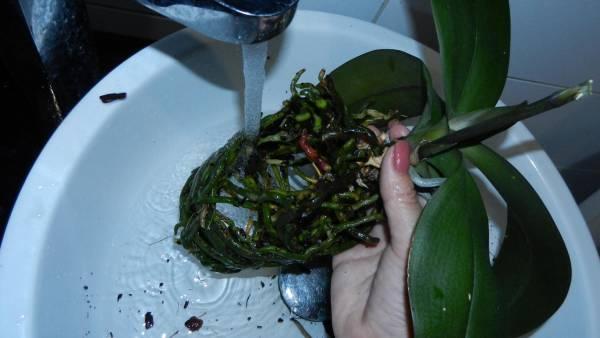
If the roots of your orchid are alive, then it can be quite simple to identify them. They are always very dense (here the color does not affect this density in any way) and hard enough if you feel them. If the horses are already rotten, then they are hollow to the touch. Also, if the roots have rotted, then when you click on them, then water will simply flow from such "rotten", or some semblance of a thread will be exposed.
Fungi are the most common cause of root rot in orchids. If this is the case in your case, then soak the plant in a fungicide.
The orchid has rotted roots. We form new
When you dry your orchid and remove all rotten roots, then you will need to soak it (to form new roots) in the root former. In terms of time, this procedure can take from 10 minutes or more, up to one and a half hours or even two. Such drugs can be "Epin" or its "relatives" "Kornevin" or "Zircon".
- Soaking itself is best done in a homemade greenhouse, or for this purpose you can take a plastic container from any cake. Also a very good option for such a greenhouse. At the bottom of such a greenhouse, you will need to place sphagnum moss, then add a little water there. That is, your task is only to moisten this moss. It should not be wet. Next, the orchid will need to be laid on its side directly on the moss. And you should put it on its side where you plan to get completely new roots.
- In summer, you will not experience problems with sprouting new roots. All you need to do is put this greenhouse on the Ideal option is the south window or the west one. There bright rays the sun will do their job. They will warm up the entire mini-greenhouse and the water will slowly evaporate from the moss surface. With such evaporation, the steam necessary for the plant will be formed in the greenhouse. It is this pair that will contribute to the growth of new roots in your orchid.
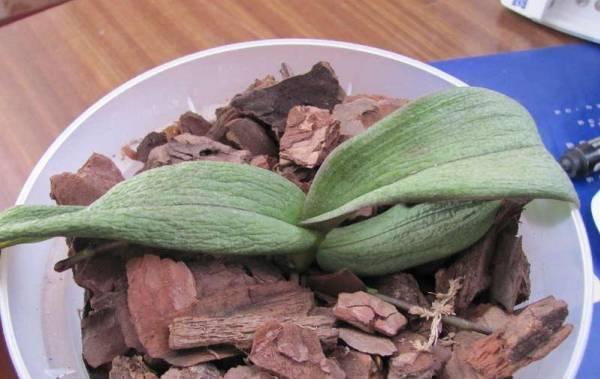
- In winter, it will be much more difficult to "catch up" such heat into the greenhouse, and, therefore, it will be very difficult to achieve steam release. You can use a heating battery for this. Place a greenhouse with an orchid right on top of it. So it will warm up well from below, and the water will slowly evaporate. Another option is to put a glass of boiling water inside your greenhouse. This should be done at least once a day. The process of resuscitation of your orchid will go much faster at a temperature of 32-33 degrees and at a humidity level of 95 or even 100 percent. The root system itself, under such conditions, will begin to actively grow at about the 2nd - 4th week.
- With such a stay in the greenhouse, the orchid will constantly come into contact with wet moss. At the same time, you need to carefully monitor her and these places of contact should be constantly monitored. If in such a place there is even a slight darkening, or water begins to accumulate in such areas, then immediately the orchid will need to be removed from the greenhouse and dried well. When it dries up, we return it to the greenhouse again, but so that it comes into contact with the moss in a different place.
- So that moisture does not arise in the greenhouse, it will be necessary to ventilate it. Do not forget to carry out such ventilation, once a day. It is better to do this when it is dark, that is, in the evening or even at night. In winter, you need to open the greenhouse lid in the evenings for only 15 or 20 minutes. In summer, you can open the whole greenhouse and let it “breathe” like that all night.
Bright light from the sun is one of the main conditions for the successful recovery of your orchid. Also, high humidity in the greenhouse and the same high temperature are required. This must be remembered!
- Only the condition of the plant itself will directly determine the total duration of such resuscitation. In general, this process can last only a month, and maybe even a whole year. Wait until the roots of your reanimated orchid grow up to 3 to 4 centimeters. After that, it will be quite possible to transplant it into a substrate familiar to it, and then it will be organized as for an ordinary, completely healthy plant.
- But still, for a start, the pot must be very small. The diameter of such a small pot should not be more than 8 centimeters. Such a small pot will help the orchid dry out faster after the next watering. Small peat pots, which are usually used for, are also quite a good option in this case. Such a pot is generally an ideal solution. After all, all the same, later the orchid will have to when the roots have already grown decently. And you don't need to take it out of such a pot. Just put it in another pot (larger), along with the plant and sprinkle it with bark on all sides.
- So that your orchid in such a pot does not move freely and cannot damage its new and still very fragile roots, it is better to fix it somehow. To do this, you can simply stick any stick directly into the pot and tie the plant to it. Or another option is to wrap the orchid with threads along with the pot itself, that is, you will have to tie it directly to the pot, as it were. It will take 2-4 weeks and your orchid is already well fixed in the pot, and then you simply remove all these props.
But in this video you will be shown the result of such an orchid resuscitation, when its leaves wither and roots rot. We look.
For a long time, your favorite delighted you with her beauty. And, suddenly, you notice wilting. Possibly a subsequent fall. Leaves and flowers have such a nuisance. What happened? It is necessary to understand in detail.
- 1 What if the leaves wilt?
- 1.1 Reasons for wilting orchid leaves:
- 1.2 Methods for treating wilting leaves
- 1.3 How to rescue?
- 2 What if the flowers wither?
- 2.1 Treatment methods
What if the leaves wither?
It's hard to watch when the plant that you have been grooming is withering away. Moreover, there are species that differ precisely in their gorgeous foliage. But then they wither, turn yellow, and then fall off. Obviously, your beauty is either sick, or you screwed up with leaving. Debriefing always begins by identifying factors.
Reasons for wilting orchid leaves:
- Overheating of the roots.
Phalaenopsis are thermophilic. But everything has its own measure. Invalid things: your flower is constantly "under the gun" of the sun's rays. Hot air from an air conditioner is directed at it. The heating battery under the window sill on which the pot stands is too hot. Plus low humidity (50% or less).
What's happening?
The trunk, leaves, flowers get very hot. An active process of moisture evaporation begins. The soil also suffers. It overheats by evaporating water. The result is the cooling of the root system. "Cold" roots no longer consume the required amount of moisture. This means the leaves are not getting any nutrients. Result: flabbiness, yellowness, wilting. Everything happens quickly, in a few hours.
- Serious root damage
The following troubles occur with the root system: decay; drying out. Why? The first priority is the wrong care. The main factors influencing these processes:
- High humidity
Orchid is an epiphytic plant. That is, having "bare" roots. They fasten it to rocks, trees, caves. Frequent, warm tropical rains water the root system abundantly. And since it is not reinforced with soil, the water completely drains away. The warm air dries out the roots. So, until the next rain.
Home conditions do not allow much to keep such a flower with bare roots. This requires more care. Therefore, most varieties grow in soil. Let's say the pot is not chosen correctly (the wrong size), without enough holes. Then, with abundant watering, the substrate will always be wet. Disease may occur. When the roots acquire a brown tint, lose their elasticity, become lethargic, it means that problems have begun.
How to fix it?
It's simple. Bring the conditions of keeping the pet as close to natural as possible. Abundant watering with warm water - draining - drying. Drying is ensured by good air circulation in the room. Do frequent airing, avoiding drafts.
- Low humidity
The other extreme of the previous point. If an "experienced" florist tells you to water Phalaenopsis strictly every day, ignore such advice. First, each plant requires an individual approach. Affects species, origin. Second: meteorological parameters change daily. Such as: air temperature, humidity, sunshine, cloudiness. This is the starting point. In dry weather, high temperatures, water more often. When it gets cold or frosty, reduce watering. Be guided by the state of the substrate. It should be loose, moist (but not wet!).
- Incorrect feeding
Many people think: the more fertilizer, the better. This is not true. There are dressings where the concentration of minerals is different. The roots are extremely sensitive to this or that substance. Suddenly, there will be an overload of salts, the plant may die. It also takes into account the variety, periods of growth, dormancy, flowering.
- Soil compaction
Sometimes the orchid is transplanted into a new pot that has new soil. First, the root system grows, the old pot becomes small. The roots also suffer. Secondly, due to abundant watering, salts, the appearance of mold, fungi, the substrate is destroyed. It becomes denser. Air circulation is impaired. The roots feel a lack of oxygen. Consequence - they "suffocate" and die.
Roots are the circulatory system of the plant. Therefore, the combination of these factors causes problems, as well as in leaves.
Methods for treating wilting leaves
- Overheating: your actions. Create a shadow for the plant (just carry it into the interior of the room). Do not immediately fill it with water or spray it! Such actions cause the death of parts. Let it cool completely. The rest will take 2-4 hours. Then water in the usual way.
The water balance is restored up to four days. The regeneration of the affected parts is unlikely to happen overnight. So be patient.
If such a nuisance has occurred, find a comfortable zone for the flower. It is impossible to completely deprive the sunlight. Give him a table near the window. Or another part of the house. Perhaps the side of the world is simply not suitable for him.
- Root Damage: Your Action
When foliage withers, overheating plays a role only in 10% of cases. The rest is a violation of the function of the roots. Three degrees of injury are conventionally considered: light, medium, severe, very severe. Unlike the first three, the last degree means the death of the root system, and therefore the plant.
How to save?
- Take the phalaenopsis by the trunk, gently wiggle it back and forth. Does it sit firmly in the ground? The probable cause is drought. It's OK.
- Move the pot away from the heat source. Let him rest for one hour.
- After, place the flower in a container of water. Temperature +30 - +40 degrees. Let it stand for about an hour.
- Eliminate fertilizers or stimulants immediately. Otherwise, the situation will only get worse.
- Next, give your pet a warm, plentiful shower from top to bottom. Try to bypass peduncles.
- Let the water drain completely. Dry the leaves with a natural cloth. Better cotton.
- Find a well-lit area for your orchid, avoiding direct sunlight. The air temperature is moderate, +18 - 25 degrees.
- Wait 2-3 days, foliage will recover.
If there is no regeneration, it means that you started “resuscitation” late. In this case, atrophy of leaf tissues occurs. Or the death of some of the roots.
When the substrate with roots moves freely, remove it. Examine the root system carefully. What can you see there?
Living roots. Most often they are green in different shades. The main thing is elastic, solid, dense. Young roots are whitish when dry. Wet ones turn green. The old ones are darker.
Rotten roots. They are easy to identify. They are brown, soft, slippery. They resemble a hollow tube, when squeezed, moisture flows out.
What to do?
Inspect carefully. Remove the rotten, dried part with a sterile knife. Everything should be removed until healthy tissue. Sprinkle the slices with crushed activated charcoal. Alcohol-based disinfectants will only do harm. As they dry, they can "kill" the green part of the root.
Even if there is only one living root left, the plant may well recover. Plant the root (at least 5-6 cm long) in a small bowl with fresh, damp substrate. When it's dry, renew your regular watering.
What if the flowers wither?
What a pity when the luxurious buds suddenly fall off. There are reasons for everything. The plant is also a living being.
The factors causing these processes are almost the same as during wilting, leaf fall. We will just add something.
Changing your place of residence is not always enjoyable. Orchids are especially hard to tolerate. You bought a gorgeous flowering plant. They brought him home. Then the trouble began. Just moving, plus a new place, influenced your beauty so much. A different climate, different conditions of detention - enough for the flowers to begin to fall.

- Natural aging
Withering, dropping, dying off is a natural process. There is no eternal bloom. Some delight us with beautiful buds for a week or two. Others last for several months. In addition, it is not known how much phalaenopsis bloomed before you acquired it. Perhaps, when buying, this period was just ending.
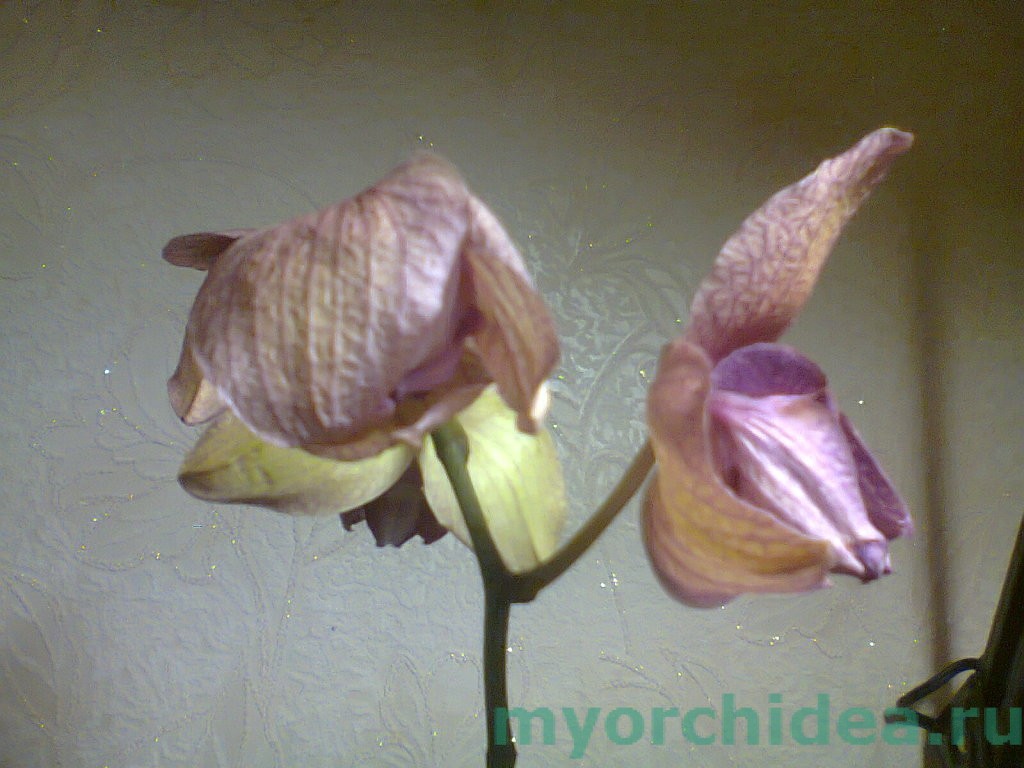
- Hypothermia
Orchids are thermophilic. Transporting it in winter is one of the reasons for the problem. Even when packaged well. At home, the temperature is also less than permissible. It is set at 22 - 32 degrees. Depends on the periods. Stick to modes. Especially the humidity of the air. The average rate is 70%. Its deficiency also serves as a factor in the dropping of flowers.
- Draft
Orchids need good air circulation. But the draft is destructive. It is enough to thoroughly ventilate the room.
- Food location nearby
Especially vegetables and fruits. Some of them release ethylene. This gas stimulates the ripening of flowers, even unopened buds. Rapid ripening leads to early wilting. Therefore, remove all food from the flower.
- Pollination
In warm periods, the pot is taken out to the open balcony, "to breathe". Small insects pollinate the plant. When everything goes well, the withering flower will replace the seed pod. If not, then it will disappear.
- Pests
Mealybugs are especially damaging. He loves the juice of the buds. Outwardly it looks like cotton wool. Leaves behind a sticky mark.
Treatment methods
Same as when leaves fall. Hypothermia causes the death of the plant. When stressed, provide natural care.
Check daily for harmful insects. Found - isolate the orchid from others. Remove the pest completely. Treat with insecticide. Take good care of your pet and everything will be fine!
